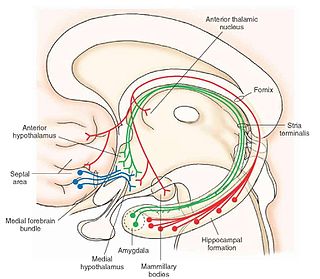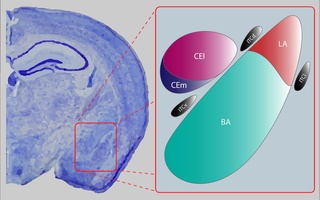Amygdala

Basolateral nucleus
The basolateral nucleus is by far the largest part of the amygdala. The fibers leading from it to the central nucleus “provide a key link between the experience of emotions and their expression.” [5]
The basolateral nucleus includes five parts: the posterolateral part, the ventromedial part, the intermediate part, the dorsal part, and the ventrolateral part. [6]
Inputs to the basolateral nucleus include visual, auditory, and somatosensory information. [7] The basolateral nucleus is in close communication with the cerebral cortex, and in terms of function, the basolateral nucleus is more like the cerebral cortex than is the central nucleus. [8] The basolateral nucleus differs from the cortex in that it is not layered, but it includes pyramidal neurons, is continuous with the parahippocampal cortex, and has extensive connections with the other parts of the cortex. [5] Its strongest direct connections to the cerebral cortex are with the insular cortex, the orbital cortex, and the medial wall of the frontal lobe. These connections allow the basolateral nucleus to receive and modulate sensory and polysensory processing. The neurotransmitter in each of these connections is either glutamate or aspartate. [8] Both the neocortex and the basolateral nucleus receive diffuse cholinergic (acetylcholine) projections from the nucleus basalis of Meynert. [7]
Stimulation of the basolateral nucleus causes a reduction in feeding, and stimulation of the basolateral nuclear group causes an increase in arousal and attention. [8] The components of the basolateral nuclear group include the basolateral nucleus, lateral nucleus, and the basomedial nucleus. [6]
The basolateral nucleus cooperates with the central nucleus in persistent fear responses. It influences regions of the brainstem through the central nucleus via the amygdalofugal pathway and the stria terminalis. [9] In mice, the basolateral nucleus mediates anxiety. [8]
Oxytocin has been visualized in the basolateral nuclei. [10] In one study, prescription opioid patients were found to have decreased anisotropy in the amygdalofugal pathway. [11]
Central nucleus
The central nucleus can be thought of as the exit of the amygdaloid bodies through which the bodily responses that are associated with fear leave the amygdala. [12] It is the most peptide-rich region of the brain. [8]
The amygdalofugal pathway connects the central nucleus of the amygdala to the brainstem. The stria terminalis does so also but in a longer, less direct route. [9] These connections collectively are involved with emotional responses. [13] The brainstem regions that the central nucleus connects to are responsible for controlling “expression of innate behaviors and associated physiological responses.” The central nucleus also has three subnuclei: lateral, capsular, and medial. It is the medial subnucleus that forms connections with “response control regions.” Most of the projection neurons in the central nucleus are inhibitory. [14]
The nucleus basalis also connects the central nucleus of the amygdala to the cortex through cholinergic projections that “are thought to arouse the cortex.” [13]
Lesion experiments show that the central nucleus of the amygdala connects with the startle circuit via the caudal part of the amygdalofugal pathway. This is the part of the pathway that projects directly to the parts of the pons, medulla, and perhaps the spinal cord. [15]
Conscious perception of emotion involves output from the central nucleus of the amygdala as well as its connections through the amygdalofugal pathway to the anterior cingulate cortex, orbitofrontal cortex, and prefrontal cortex. [13]
















